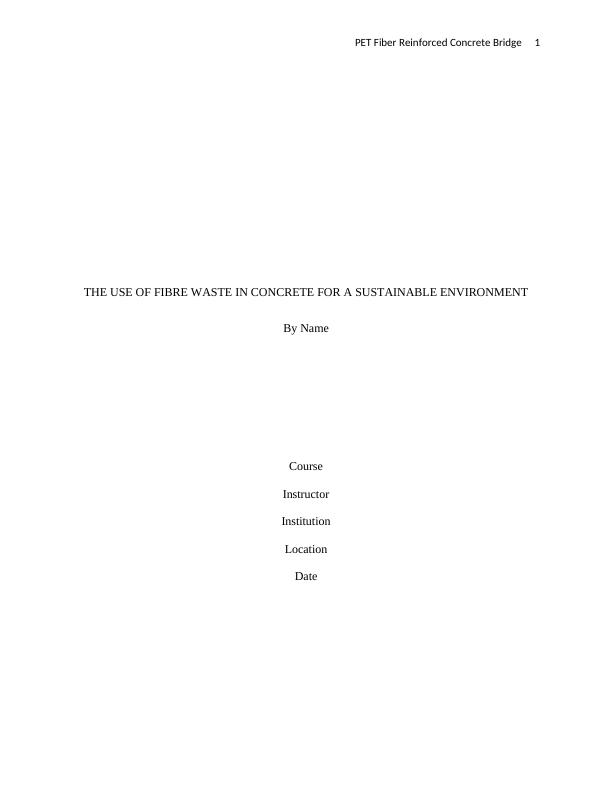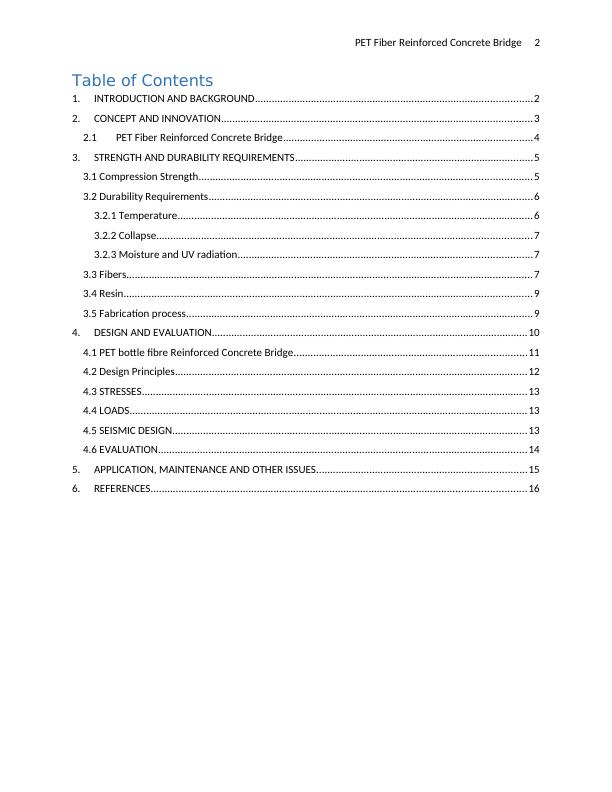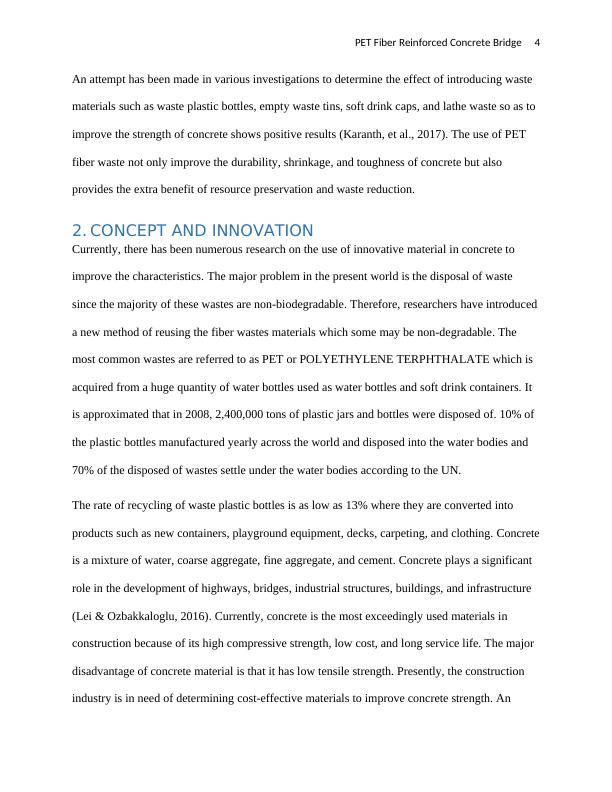PET Fiber Reinforced Concrete Bridge
Added on 2023-03-29
18 Pages4575 Words418 Views
PET Fiber Reinforced Concrete Bridge 1
THE USE OF FIBRE WASTE IN CONCRETE FOR A SUSTAINABLE ENVIRONMENT
By Name
Course
Instructor
Institution
Location
Date
THE USE OF FIBRE WASTE IN CONCRETE FOR A SUSTAINABLE ENVIRONMENT
By Name
Course
Instructor
Institution
Location
Date

PET Fiber Reinforced Concrete Bridge 2
Table of Contents
1. INTRODUCTION AND BACKGROUND...................................................................................................2
2. CONCEPT AND INNOVATION...............................................................................................................3
2.1 PET Fiber Reinforced Concrete Bridge.........................................................................................4
3. STRENGTH AND DURABILITY REQUIREMENTS.....................................................................................5
3.1 Compression Strength.......................................................................................................................5
3.2 Durability Requirements....................................................................................................................6
3.2.1 Temperature...............................................................................................................................6
3.2.2 Collapse......................................................................................................................................7
3.2.3 Moisture and UV radiation.........................................................................................................7
3.3 Fibers.................................................................................................................................................7
3.4 Resin..................................................................................................................................................9
3.5 Fabrication process............................................................................................................................9
4. DESIGN AND EVALUATION.................................................................................................................10
4.1 PET bottle fibre Reinforced Concrete Bridge...................................................................................11
4.2 Design Principles..............................................................................................................................12
4.3 STRESSES..........................................................................................................................................13
4.4 LOADS..............................................................................................................................................13
4.5 SEISMIC DESIGN...............................................................................................................................13
4.6 EVALUATION....................................................................................................................................14
5. APPLICATION, MAINTENANCE AND OTHER ISSUES...........................................................................15
6. REFERENCES......................................................................................................................................16
Table of Contents
1. INTRODUCTION AND BACKGROUND...................................................................................................2
2. CONCEPT AND INNOVATION...............................................................................................................3
2.1 PET Fiber Reinforced Concrete Bridge.........................................................................................4
3. STRENGTH AND DURABILITY REQUIREMENTS.....................................................................................5
3.1 Compression Strength.......................................................................................................................5
3.2 Durability Requirements....................................................................................................................6
3.2.1 Temperature...............................................................................................................................6
3.2.2 Collapse......................................................................................................................................7
3.2.3 Moisture and UV radiation.........................................................................................................7
3.3 Fibers.................................................................................................................................................7
3.4 Resin..................................................................................................................................................9
3.5 Fabrication process............................................................................................................................9
4. DESIGN AND EVALUATION.................................................................................................................10
4.1 PET bottle fibre Reinforced Concrete Bridge...................................................................................11
4.2 Design Principles..............................................................................................................................12
4.3 STRESSES..........................................................................................................................................13
4.4 LOADS..............................................................................................................................................13
4.5 SEISMIC DESIGN...............................................................................................................................13
4.6 EVALUATION....................................................................................................................................14
5. APPLICATION, MAINTENANCE AND OTHER ISSUES...........................................................................15
6. REFERENCES......................................................................................................................................16

PET Fiber Reinforced Concrete Bridge 3
1. INTRODUCTION AND BACKGROUND
The research and development of various approaches and materials in civil engineering are
aimed at determining the outcome in which the financial constraints, environmental preservation
or compatibility, and availability aspects are considered. Consequently, the construction material
selection should only be made after a thorough assessment of environmental preservation or
compatibility, durability in the structure, and long-term performance. Concrete is a composite
construction material composed of majorly water, cement, and aggregate (Shoeb & Chavan,
2016). Fibre waste such as wastes from natural fibers, synthetic fibers, glass fibers, and steel
fibers, can be used in concrete to control cracking caused by drying shrinkage and plastic
shrinkage.
The use of natural fibers in construction materials has taken place since ancient times through
strengthening of mortar with horse hair or use of straw in sun-dried mud brick. Fibers have been
applied in the reinforcement of construction concrete since time memorial. The asbestos fibers
were used in concrete in the 1900s. The concept of fibre-reinforcement and composite materials
became interesting topics in the 1950s (Ransubhe, 2018). Once the health risks related to
asbestos were revealed, there was a need to determine a replacement for the substances in
concrete and other construction materials. The synthetic, glass, and steel fibers were used in
concrete by the 1960s. The benefits of using fibers can assist in reducing the cost of building and
also conserving the environment through optimization of agricultural and plant waste.
Currently, concrete is the most exceedingly used materials in construction because of its high
compressive strength, low cost, and long service life. The major shortcoming of concrete
material is that it has low tensile strength. There is a need to improve the strength of concrete by
the construction industry by determining cost-effective materials to introduce into the concrete.
1. INTRODUCTION AND BACKGROUND
The research and development of various approaches and materials in civil engineering are
aimed at determining the outcome in which the financial constraints, environmental preservation
or compatibility, and availability aspects are considered. Consequently, the construction material
selection should only be made after a thorough assessment of environmental preservation or
compatibility, durability in the structure, and long-term performance. Concrete is a composite
construction material composed of majorly water, cement, and aggregate (Shoeb & Chavan,
2016). Fibre waste such as wastes from natural fibers, synthetic fibers, glass fibers, and steel
fibers, can be used in concrete to control cracking caused by drying shrinkage and plastic
shrinkage.
The use of natural fibers in construction materials has taken place since ancient times through
strengthening of mortar with horse hair or use of straw in sun-dried mud brick. Fibers have been
applied in the reinforcement of construction concrete since time memorial. The asbestos fibers
were used in concrete in the 1900s. The concept of fibre-reinforcement and composite materials
became interesting topics in the 1950s (Ransubhe, 2018). Once the health risks related to
asbestos were revealed, there was a need to determine a replacement for the substances in
concrete and other construction materials. The synthetic, glass, and steel fibers were used in
concrete by the 1960s. The benefits of using fibers can assist in reducing the cost of building and
also conserving the environment through optimization of agricultural and plant waste.
Currently, concrete is the most exceedingly used materials in construction because of its high
compressive strength, low cost, and long service life. The major shortcoming of concrete
material is that it has low tensile strength. There is a need to improve the strength of concrete by
the construction industry by determining cost-effective materials to introduce into the concrete.

PET Fiber Reinforced Concrete Bridge 4
An attempt has been made in various investigations to determine the effect of introducing waste
materials such as waste plastic bottles, empty waste tins, soft drink caps, and lathe waste so as to
improve the strength of concrete shows positive results (Karanth, et al., 2017). The use of PET
fiber waste not only improve the durability, shrinkage, and toughness of concrete but also
provides the extra benefit of resource preservation and waste reduction.
2. CONCEPT AND INNOVATION
Currently, there has been numerous research on the use of innovative material in concrete to
improve the characteristics. The major problem in the present world is the disposal of waste
since the majority of these wastes are non-biodegradable. Therefore, researchers have introduced
a new method of reusing the fiber wastes materials which some may be non-degradable. The
most common wastes are referred to as PET or POLYETHYLENE TERPHTHALATE which is
acquired from a huge quantity of water bottles used as water bottles and soft drink containers. It
is approximated that in 2008, 2,400,000 tons of plastic jars and bottles were disposed of. 10% of
the plastic bottles manufactured yearly across the world and disposed into the water bodies and
70% of the disposed of wastes settle under the water bodies according to the UN.
The rate of recycling of waste plastic bottles is as low as 13% where they are converted into
products such as new containers, playground equipment, decks, carpeting, and clothing. Concrete
is a mixture of water, coarse aggregate, fine aggregate, and cement. Concrete plays a significant
role in the development of highways, bridges, industrial structures, buildings, and infrastructure
(Lei & Ozbakkaloglu, 2016). Currently, concrete is the most exceedingly used materials in
construction because of its high compressive strength, low cost, and long service life. The major
disadvantage of concrete material is that it has low tensile strength. Presently, the construction
industry is in need of determining cost-effective materials to improve concrete strength. An
An attempt has been made in various investigations to determine the effect of introducing waste
materials such as waste plastic bottles, empty waste tins, soft drink caps, and lathe waste so as to
improve the strength of concrete shows positive results (Karanth, et al., 2017). The use of PET
fiber waste not only improve the durability, shrinkage, and toughness of concrete but also
provides the extra benefit of resource preservation and waste reduction.
2. CONCEPT AND INNOVATION
Currently, there has been numerous research on the use of innovative material in concrete to
improve the characteristics. The major problem in the present world is the disposal of waste
since the majority of these wastes are non-biodegradable. Therefore, researchers have introduced
a new method of reusing the fiber wastes materials which some may be non-degradable. The
most common wastes are referred to as PET or POLYETHYLENE TERPHTHALATE which is
acquired from a huge quantity of water bottles used as water bottles and soft drink containers. It
is approximated that in 2008, 2,400,000 tons of plastic jars and bottles were disposed of. 10% of
the plastic bottles manufactured yearly across the world and disposed into the water bodies and
70% of the disposed of wastes settle under the water bodies according to the UN.
The rate of recycling of waste plastic bottles is as low as 13% where they are converted into
products such as new containers, playground equipment, decks, carpeting, and clothing. Concrete
is a mixture of water, coarse aggregate, fine aggregate, and cement. Concrete plays a significant
role in the development of highways, bridges, industrial structures, buildings, and infrastructure
(Lei & Ozbakkaloglu, 2016). Currently, concrete is the most exceedingly used materials in
construction because of its high compressive strength, low cost, and long service life. The major
disadvantage of concrete material is that it has low tensile strength. Presently, the construction
industry is in need of determining cost-effective materials to improve concrete strength. An

End of preview
Want to access all the pages? Upload your documents or become a member.
Related Documents
Behavior of Plastic Fibers in Concretelg...
|15
|2999
|316
ENGR8862 Structural Engineeringlg...
|13
|2341
|248
Fibre Reinforced Polymer Confinement of RC Columnslg...
|15
|3370
|122
Mud bricks can be used for building and constructionlg...
|16
|2310
|27
Bendable Concrete 13 Running Head: Polyvinyl Alcohol in Creating a Bendable Concretelg...
|15
|3774
|405
Synthetic Mineral Fibre: Definition, Usage, and Advantageslg...
|6
|1330
|206
